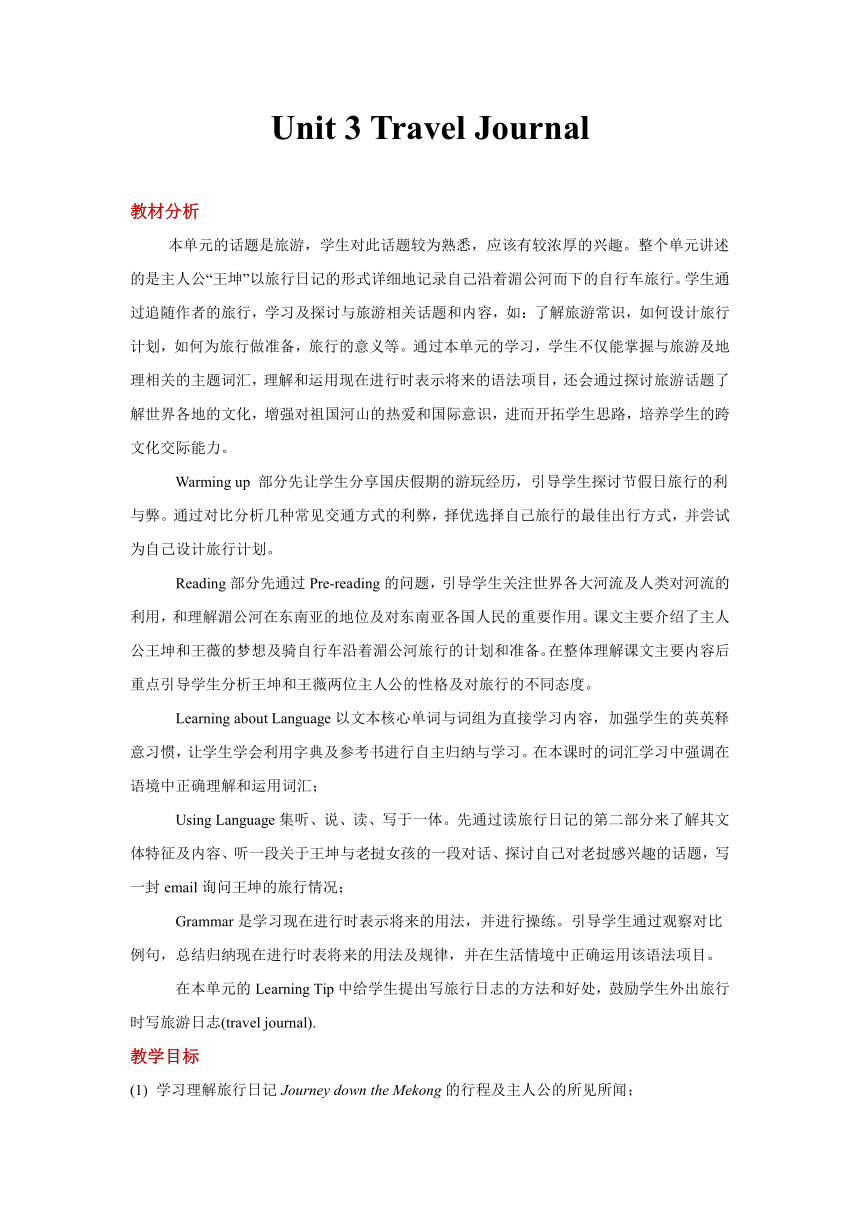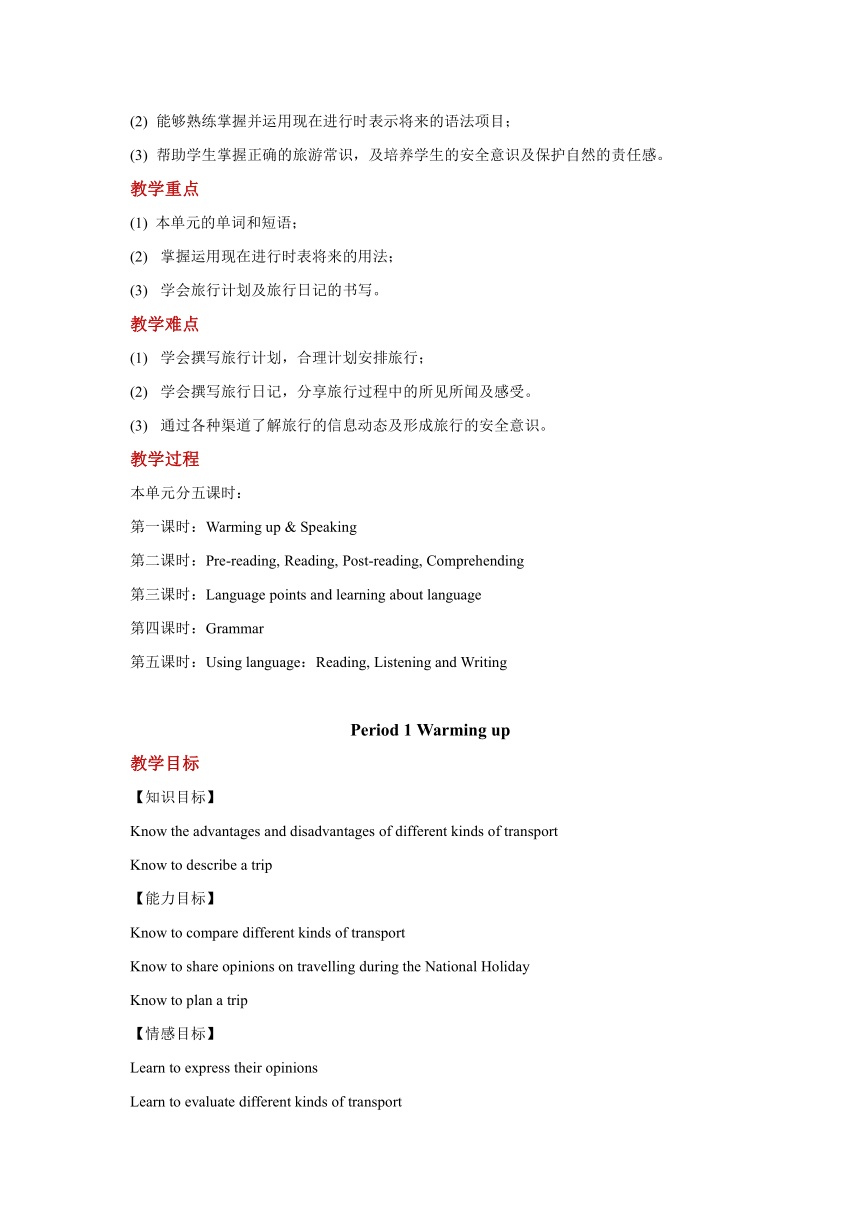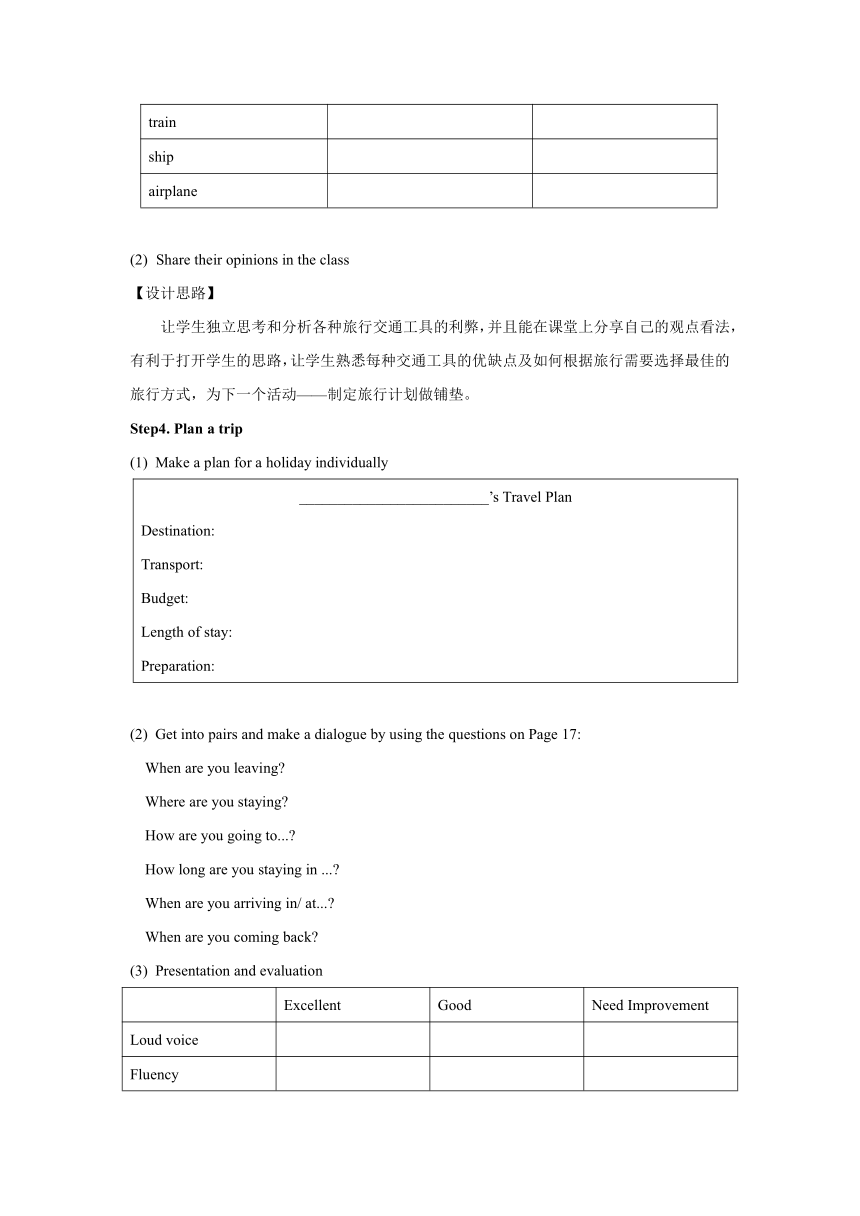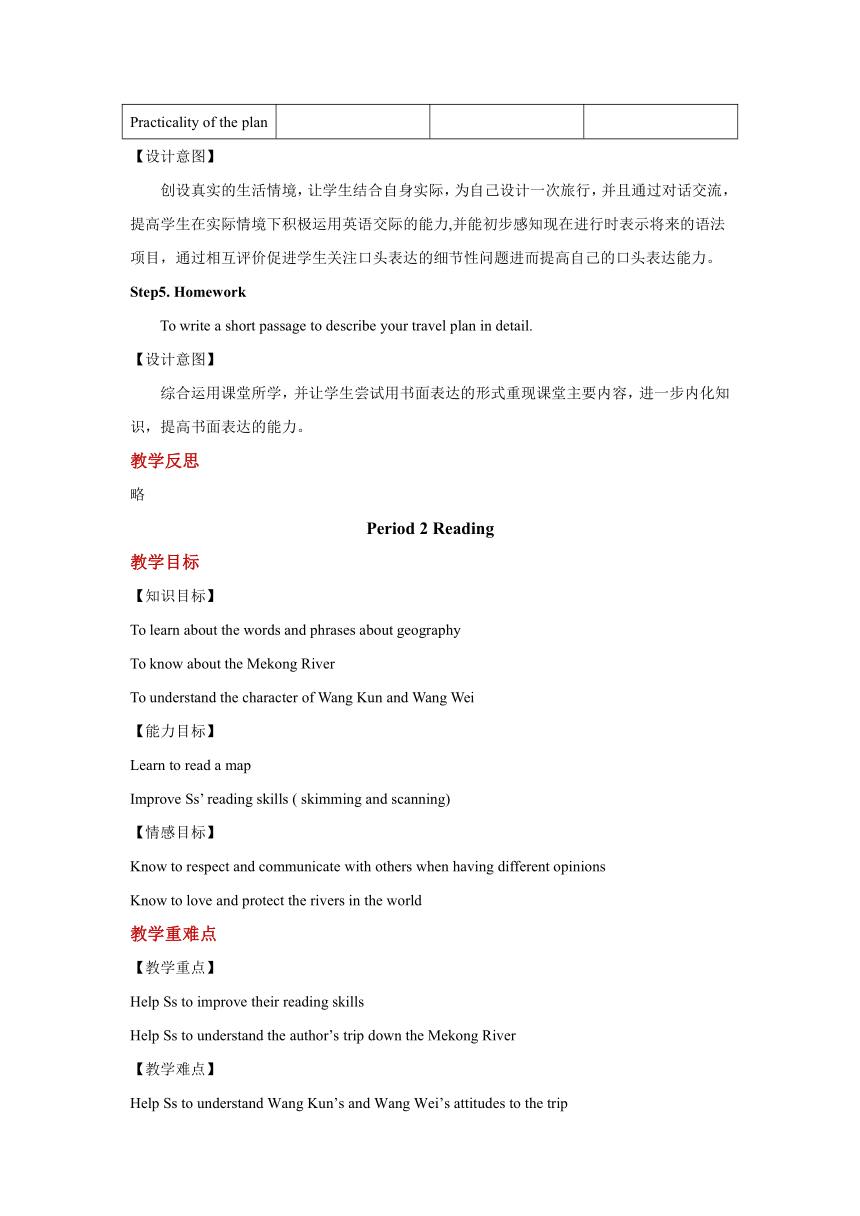Unit 3 Travel Journal单元教案
文档属性
| 名称 | Unit 3 Travel Journal单元教案 |  | |
| 格式 | zip | ||
| 文件大小 | 39.3KB | ||
| 资源类型 | 教案 | ||
| 版本资源 | 人教版(新课程标准) | ||
| 科目 | 英语 | ||
| 更新时间 | 2019-07-28 22:06:32 | ||
图片预览





文档简介
Unit 3 Travel Journal
教材分析
本单元的话题是旅游,学生对此话题较为熟悉,应该有较浓厚的兴趣。整个单元讲述的是主人公“王坤”以旅行日记的形式详细地记录自己沿着湄公河而下的自行车旅行。学生通过追随作者的旅行,学习及探讨与旅游相关话题和内容,如:了解旅游常识,如何设计旅行计划,如何为旅行做准备,旅行的意义等。通过本单元的学习,学生不仅能掌握与旅游及地理相关的主题词汇,理解和运用现在进行时表示将来的语法项目,还会通过探讨旅游话题了解世界各地的文化,增强对祖国河山的热爱和国际意识,进而开拓学生思路,培养学生的跨文化交际能力。
Warming up 部分先让学生分享国庆假期的游玩经历,引导学生探讨节假日旅行的利与弊。通过对比分析几种常见交通方式的利弊,择优选择自己旅行的最佳出行方式,并尝试为自己设计旅行计划。
Reading部分先通过Pre-reading的问题,引导学生关注世界各大河流及人类对河流的利用,和理解湄公河在东南亚的地位及对东南亚各国人民的重要作用。课文主要介绍了主人公王坤和王薇的梦想及骑自行车沿着湄公河旅行的计划和准备。在整体理解课文主要内容后重点引导学生分析王坤和王薇两位主人公的性格及对旅行的不同态度。
Learning about Language以文本核心单词与词组为直接学习内容,加强学生的英英释意习惯,让学生学会利用字典及参考书进行自主归纳与学习。在本课时的词汇学习中强调在语境中正确理解和运用词汇;
Using Language集听、说、读、写于一体。先通过读旅行日记的第二部分来了解其文体特征及内容、听一段关于王坤与老挝女孩的一段对话、探讨自己对老挝感兴趣的话题,写一封email询问王坤的旅行情况;
Grammar是学习现在进行时表示将来的用法,并进行操练。引导学生通过观察对比例句,总结归纳现在进行时表将来的用法及规律,并在生活情境中正确运用该语法项目。
在本单元的Learning Tip中给学生提出写旅行日志的方法和好处,鼓励学生外出旅行时写旅游日志(travel journal).
教学目标
学习理解旅行日记Journey down the Mekong的行程及主人公的所见所闻;
能够熟练掌握并运用现在进行时表示将来的语法项目;
帮助学生掌握正确的旅游常识,及培养学生的安全意识及保护自然的责任感。
教学重点
(1) 本单元的单词和短语;
(2) 掌握运用现在进行时表将来的用法;
(3) 学会旅行计划及旅行日记的书写。
教学难点
(1) 学会撰写旅行计划,合理计划安排旅行;
(2) 学会撰写旅行日记,分享旅行过程中的所见所闻及感受。
(3) 通过各种渠道了解旅行的信息动态及形成旅行的安全意识。
教学过程
本单元分五课时:
第一课时:Warming up & Speaking
第二课时:Pre-reading, Reading, Post-reading, Comprehending
第三课时:Language points and learning about language
第四课时:Grammar
第五课时:Using language:Reading, Listening and Writing
Period 1 Warming up
教学目标
【知识目标】
Know the advantages and disadvantages of different kinds of transport
Know to describe a trip
【能力目标】
Know to compare different kinds of transport
Know to share opinions on travelling during the National Holiday
Know to plan a trip
【情感目标】
Learn to express their opinions
Learn to evaluate different kinds of transport
教学重难点
【教学重点】
Different opinions of travelling during the National Holiday
The advantages and disadvantages of different kinds of transport
【教学难点】
Learn to plan a trip
课前准备
Tape recorder, Multimedia
教学过程
Step1. Warming up
Did you go travelling during the National Day holiday?
Where did you go ? What did you do?
How did you feel about your trip?
【设计意图】
通过引导学生分享国庆假期的旅行经历激发学生的兴趣,引入本单元的学习话题——旅游。以问题引导学生描述旅行过程中的所见所闻和感受。
Step2. Discussion
Do you like travelling during the National Day holiday? Why or why not?
Do you think travelling during the National Day holiday might cause problems? What might be the problems?
【设计意图】
让学生通过讨论,积极思考是否所有人都喜欢在节假日旅行及国庆假期旅行的利与弊,并敢于分析问题和分享看法。引导学生从多方面多角度对问题进行分析和思考,在课堂教学中逐步培养学生的批判性思维。
Step3. Making a comparison
Brainstorm the advantages and disadvantages of different kinds of transport. (Page 17 Activity 1)
Transport Advantages Disadvantages
bus
train
ship
airplane
Share their opinions in the class
【设计思路】
让学生独立思考和分析各种旅行交通工具的利弊,并且能在课堂上分享自己的观点看法,有利于打开学生的思路,让学生熟悉每种交通工具的优缺点及如何根据旅行需要选择最佳的旅行方式,为下一个活动——制定旅行计划做铺垫。
Step4. Plan a trip
Make a plan for a holiday individually
_________________________’s Travel Plan Destination: Transport: Budget: Length of stay: Preparation:
Get into pairs and make a dialogue by using the questions on Page 17:
When are you leaving?
Where are you staying?
How are you going to...?
How long are you staying in ...?
When are you arriving in/ at...?
When are you coming back?
Presentation and evaluation
Excellent Good Need Improvement
Loud voice
Fluency
Practicality of the plan
【设计意图】
创设真实的生活情境,让学生结合自身实际,为自己设计一次旅行,并且通过对话交流,提高学生在实际情境下积极运用英语交际的能力,并能初步感知现在进行时表示将来的语法项目,通过相互评价促进学生关注口头表达的细节性问题进而提高自己的口头表达能力。
Step5. Homework
To write a short passage to describe your travel plan in detail.
【设计意图】
综合运用课堂所学,并让学生尝试用书面表达的形式重现课堂主要内容,进一步内化知识,提高书面表达的能力。
教学反思
略
Period 2 Reading
教学目标
【知识目标】
To learn about the words and phrases about geography
To know about the Mekong River
To understand the character of Wang Kun and Wang Wei
【能力目标】
Learn to read a map
Improve Ss’ reading skills ( skimming and scanning)
【情感目标】
Know to respect and communicate with others when having different opinions
Know to love and protect the rivers in the world
教学重难点
【教学重点】
Help Ss to improve their reading skills
Help Ss to understand the author’s trip down the Mekong River
【教学难点】
Help Ss to understand Wang Kun’s and Wang Wei’s attitudes to the trip
Help Ss to analyze the characters of Wang Kun and Wang Wei
课前准备
Tape recorder, Multimedia
教学过程
Step1. Warm-up
A competition between groups:
Which country is Mississippi River located in?
Which country is Thames River located in?
Which river is the longest river in the world?
Which river is the second longest river in the world?
Which river is the longest river in China?
Which river is the most important river in Southeast Asia?
【设计意图】
通过小组竞赛激发学生参与课堂的积极性,并让学生了解和积累世界河流的知识,为进一步阅读理解文章做准备。
Step2. Pre-reading
Watch a video and try to answer the questions:
What are the countries that the Mekong River flows through?
What do people use the Mekong for?
【设计意图】
通过观看视频材料,让学生学会利用地图描述湄公河的位置及流经的六个国家,知道人们在生产生活中如何有效利用湄公河。
Step3. Reading
Try to predict the main idea of the passage through the title and the sub-title
Skim the whole passage and try to tell which paragraphs are about their dream and which paragraphs are about their plan.
【设计意图】
引导学生通过文章标题,小标题,图片等有效预测文章内容,并能从整体把握文章结构及段落间的逻辑关系,避免学生养成在阅读过程中忽略文章整体结构的习惯。
Scan for detailed information
Paragraph 1:
Their dream
Who
What & How
Paragraph 2: (SB P19 Comprehending Ex.3)
Wang Wei’s attitude
Wang Kun’s attitude
Paragraph 3:
The great scenery along the Mekong River
【设计意图】
在整体理解把握文章大意后,以小组合作的方式开展课文的阅读活动,小组的每位成员负责一个段落的信息查询和归纳,最后在组内分享交流,以此激发学生进行有效阅读积极思考,提高学生捕捉细节信息及归纳理解信息的能力。
Step4. Post-Reading
Discussion:
What kind of person do you think Wang Kun and Wang Wei are? Give your reasons.
Imagine you and your family have different opinions on your travel plan, how would you do?
【设计意图】
开放性讨论,让尝试学生根据课文的描述,推断人物的性格特征,同时创设生活情境,
引导学生在面对他人的不同意见时应如何处理问题,从而引导学生正确对待身边的人和遇到的问题。
Step4. Homework
SB P19 Comprehending Ex.4 (make up a dialogue)
SB P20 Discovering useful words and expressions
【设计意图】
让学生回顾课文内容,并通过知识内化后用对话的形式进行知识的再输出。
熟悉课文词汇,为下一节课的语言学习做准备。
教学反思
略
Period 3 Language Points Learning
教学目标
【知识目标】
The useful expressions from the text
The examples and practices of important words and phrases
The important structure from the text
【能力目标】
To learn words and expressions in a proper way
To conclude the use of some expressions
【情感目标】
To help students understand the new expressions
To look for a better way of learning words and expressions
教学重难点
【教学重点】
The different pattern of words and the related expression
【教学难点】
To use new expressions in different situations
课前准备
Tape recorder, Multimedia
教学过程
Step1. Warming Up
Revision (Retelling of the text)
The dream
who
What and how
Their attitudes
preparation
The great scenery
Homework checking (Asking some group members to check and share their homework)
【设计意图】
调动学生的参与性,利用课文复述检测学生对上一节课堂内容的掌握情况,通过词汇练习了解学生对新词汇的掌握情况。
Step2. Important expressions and sentence structures
Words and expressions:
(1)_________ cause sb to do sth by arguing or reasoning with him
(2) _________ complete a course for a degree
a person who holds a degree (esp the first or bachelors) from a university or polytechnic
(3)__________ having a great liking for sb / doing sth
(4) _________ determined not to give way, strong-willed
(5)__________ with one’s mind firmly made up; resolute
(6)_________ allow oneself to be defeated or overcome by sb / sth
(7)__________ a plan of what someone is going to do and when they are going to do it
(8)__________ to make the necessary arrangement so that an activity can happen effectively
Sentence structures:
It was my sister who first had the idea to cycle along the Mekong river from where it begins to where it ends.
Once she haas made up her mind, nothing can change it.
【设计意图】
通过相关词义的描述和对应选择的训练,降低学生学习词汇的难度,有助缓解学生的畏难情绪。让学生习惯通过英英互译的方法理解词汇,为过渡到使用字典进行词汇的自主学习做铺垫。
Step3. Learning in groups
Four students in a group and read the expressions and sentences
Look up the words or expressions in a dictionary and take notes
Share their notes in a group
【设计意图】
通过小组合作的学习方式,激发学生自主学习的主动性。学生通过查阅字典和工具书,学习新词汇的用法,不同的词性与意义。通过笔记的整理,完成知识的理解和内化过程,在小组分享过程中,对自主学习的词汇进行输出,进一步巩固自主学习的成果。
Step4. Presentation
Some groups to present their works in the class
To give some better suggestions
To draw a conclusion or give examples to students
【设计意图】
提供机会让学生展示自己小组的学习成果,并引导其他小组进行评价,以帮助学生完善笔记,形成相互学习,相互评价的好习惯。
Step5. Homework
Workbook Page 56 Using words and Expressions.
【设计意图】
集中练习重点单词于词组的表达与使用,巩固课堂所学知识。
Period 4 Grammar
The Present Continuous Tense: expressing futurity
教学目标
【知识目标】
To review the present continuous tense
To learn about the present continuous tense for future use
To review other ways of expressing future actions
【能力目标】
Know to express future actions in different ways
Know to express future actions fluently
【情感目标】
Know to cooperate with others
教学重难点
【教学重点】
The different ways of expressing future actions
【教学难点】
Help Ss understand the present continuous tense for future use
Help Ss apply what they learn in reality
课前准备
Tape recorder, Multimedia
教学过程
Step5.Warming up
Listen to a dialogue which is about a travel plan.
Try to write down questions in the dialogue.
Dialogue:
A: I’ve planned a trip for my holiday.
B: OK. Where are you going?
A: Lijiang and Dali in Yunnan.
B: Lovely. How are you getting there?
A: As I haven’t much time I think I need to travel by air.
B: That’s going to be very expensive. How much is fare?
A: About 1,500 yuan.
B: When are you leaving?
A: One week after school finishes for this year.
B: Sounds good to me. Where are you staying?
A: I’d like to stay in local homes.
B: That sounds fun. How long are you staying in Lijiang and how long in Dali?
A: I’m thinking of staying two nights at each place.
B: That’s good. When are you coming back?
A: Five days after I set off.
B: Great. Wish you a good trip.
【设计意图】
在听一段关于旅行计划的小对话的过程中让学生写下对话的问句,引导学生关注现在进行时的表达形式与意义,从而导入本课堂的学习——现在进行时表将来的语法项目。
Step2. Observation
Where are you going?
How are you getting there?
When are you leaving?
Where are you staying?
How long are you staying in Lijiang and how long in Dali?
When are you coming back?
Some friends are coming to Anne’s birthday party this evening. Anne’s mother is busy getting ready for the birthday dinner. Anne is helping her mother now.
结构
一般用法/ 意义
特殊用法/ 意义
【设计意图】
通过学生听写下来的问句,引导学生观察语法结构及用法,复习现在进行时一般用法的同时引导学生归纳表将来的特殊用法。
Step3. Present Continuous Tense express
The young artist is returning from Canada next week.
My mother is buying me a bike soon.
When I grow up, I’m joining the army.
I’m not waiting for him any longer.
He is so kind that he is always thinking of others.
He is always working so hard.
Sentence 1&2 指近期的、按计划或安排要发生的动作,通常带有一个表将来的时间状语,句子动词常为趋向性动词和表示位置转移的动词,如:arrive, come, do, get, go, have, leave, meet, play, return, see, spend, start, stay, wear, work 等。
Sentence 3 表示较远的将来要做的事情
Sentence 4 表示含有“决心”的意思,多用于否定结构中
Sentence 5 &6 表示反复或习惯性动作,带有情感色彩
【设计意图】
通过例句的观察和对比,让学生在一定的语境中理解现在进行时表示将来的用法及不同的意义。
Step4. Other ways to express future actions
He will be seventeen years old next month.
We are going to have a meeting today.
Are we to go on with this work?
I was about to go swimming when my guide shouted at me and told me not to do so.
The plane takes off at 10:30.
will / shall do 表示在将来某个时间要发生的动作或存在的状态
be going to do 表示即将发生的或最近打算进行的事
be to do 表示按计划要发生的事或征求对方的意见
be about to do 表示即将发生的动作, 不与表示将来的时间状语连用
一般现在时 按规定预计要发生的未来动作, 仅限于动词come, go, leave, move, start, return, arrive, begin, stay等动词
【设计意图】
让学生了解将来时的多种表达方式,引导学生明确各种表达方式的区别,从而能正确运用将来时各种表达方式。
Step5. Exercise
(1) Our English teacher ________________________(将离开)Shanghai in a few days.
(2) You ____________________ (总是在看电视)TV. Why not do something more active.
(3) We ______________________________________(将要搬去另一间酒店) tomorrow.
(4) Look at the timetable. Flight 4026 _____________________________(将于9点起飞).
(5) Everyone ___________________________________(正忙于准备) the party tonight.
【设计意图】
通过补全句子的练习让学生在特定的语境中正确运用将来时的各种表达方式。
Step6. Homework
SB page 21 Discovering useful structures Ex.2 & Ex.3
WB page57 Using structure Ex. 1
【设计意图】
重点训练现在进行时表示将来的语法项目,巩固课堂所学知识。
Period 5 Using language
Reading, Listening and Writing
教学目标
【知识目标】
To learn something about a travel journal
To learn about the Mekong River in Laos
【能力目标】
Know to organize a travel journal
Know to write an e-mail
【情感目标】
Know to share a journey in a travel journal
Know to express their feelings
教学重难点
【教学重点】
Know to organize a travel journal
【教学难点】
Know to write an e-mail
课前准备
Tape recorder, Multimedia
教学过程
Step1.Warming Up
Show some pictures
Ask Ss to predict what the reading passage is about.
【设计意图】
通过图片展示湄公河发源地的美景,让学生根据标题及图片预测文章的大意,激发学生的求知欲,为阅读文章作铺垫。
Step2. Reading
Skimming
How is the passage organize?
In order of place. B. In order of time.
What’s the main idea of the passage?
The great scenery of Tibet.
The experience of their journey in the mountains
【设计意图】
通过简单的问题,让学生关注游记的写作通常以时间为顺序开展的。在游记中作者会讲述旅行途中的所见所闻及所想。让学生对全文的结构有较清晰的认识。
Scanning
What did they see On the mountain: In the valleys:
What did they hear
What did they do 1) 2) 3) 4)
How did they feel 1) 2) 3)
【设计意图】
在把握全文结构的基础上,从细节内容上把握作者在旅行过程中的所见所闻及所想,从而让学生认识到一篇游记所涵盖的主要内容。
Step3. Listening
Listen for the main idea (SB Page23 Ex.2)
Listen for detailed information (SB Page23 Ex.3)
【设计意图】
常规听力模式,引导学生先从整体把握听力材料的大意,再进行细节信息的理解。
Step4. Writing
Brainstorm some questions
Decide what questions you want to ask in the e-mail
Write an e-mail to Wang Kun
【设计意图】
引导学生进行积极思考,在写作内容上给予适当的指引,打开学生的思路,避免学生无话可说的尴尬。学生选取自己感兴趣的问题作为e-mail的写作内容,提醒学生注意篇章结构及行文逻辑。鼓励学生在写作中正确运用现在进行时表将来的语法项目。
Step5. Homework
Swap their writing with others and help each other to improve their writing. ( grammar, punctuation, spelling mistakes, etc.)
教材分析
本单元的话题是旅游,学生对此话题较为熟悉,应该有较浓厚的兴趣。整个单元讲述的是主人公“王坤”以旅行日记的形式详细地记录自己沿着湄公河而下的自行车旅行。学生通过追随作者的旅行,学习及探讨与旅游相关话题和内容,如:了解旅游常识,如何设计旅行计划,如何为旅行做准备,旅行的意义等。通过本单元的学习,学生不仅能掌握与旅游及地理相关的主题词汇,理解和运用现在进行时表示将来的语法项目,还会通过探讨旅游话题了解世界各地的文化,增强对祖国河山的热爱和国际意识,进而开拓学生思路,培养学生的跨文化交际能力。
Warming up 部分先让学生分享国庆假期的游玩经历,引导学生探讨节假日旅行的利与弊。通过对比分析几种常见交通方式的利弊,择优选择自己旅行的最佳出行方式,并尝试为自己设计旅行计划。
Reading部分先通过Pre-reading的问题,引导学生关注世界各大河流及人类对河流的利用,和理解湄公河在东南亚的地位及对东南亚各国人民的重要作用。课文主要介绍了主人公王坤和王薇的梦想及骑自行车沿着湄公河旅行的计划和准备。在整体理解课文主要内容后重点引导学生分析王坤和王薇两位主人公的性格及对旅行的不同态度。
Learning about Language以文本核心单词与词组为直接学习内容,加强学生的英英释意习惯,让学生学会利用字典及参考书进行自主归纳与学习。在本课时的词汇学习中强调在语境中正确理解和运用词汇;
Using Language集听、说、读、写于一体。先通过读旅行日记的第二部分来了解其文体特征及内容、听一段关于王坤与老挝女孩的一段对话、探讨自己对老挝感兴趣的话题,写一封email询问王坤的旅行情况;
Grammar是学习现在进行时表示将来的用法,并进行操练。引导学生通过观察对比例句,总结归纳现在进行时表将来的用法及规律,并在生活情境中正确运用该语法项目。
在本单元的Learning Tip中给学生提出写旅行日志的方法和好处,鼓励学生外出旅行时写旅游日志(travel journal).
教学目标
学习理解旅行日记Journey down the Mekong的行程及主人公的所见所闻;
能够熟练掌握并运用现在进行时表示将来的语法项目;
帮助学生掌握正确的旅游常识,及培养学生的安全意识及保护自然的责任感。
教学重点
(1) 本单元的单词和短语;
(2) 掌握运用现在进行时表将来的用法;
(3) 学会旅行计划及旅行日记的书写。
教学难点
(1) 学会撰写旅行计划,合理计划安排旅行;
(2) 学会撰写旅行日记,分享旅行过程中的所见所闻及感受。
(3) 通过各种渠道了解旅行的信息动态及形成旅行的安全意识。
教学过程
本单元分五课时:
第一课时:Warming up & Speaking
第二课时:Pre-reading, Reading, Post-reading, Comprehending
第三课时:Language points and learning about language
第四课时:Grammar
第五课时:Using language:Reading, Listening and Writing
Period 1 Warming up
教学目标
【知识目标】
Know the advantages and disadvantages of different kinds of transport
Know to describe a trip
【能力目标】
Know to compare different kinds of transport
Know to share opinions on travelling during the National Holiday
Know to plan a trip
【情感目标】
Learn to express their opinions
Learn to evaluate different kinds of transport
教学重难点
【教学重点】
Different opinions of travelling during the National Holiday
The advantages and disadvantages of different kinds of transport
【教学难点】
Learn to plan a trip
课前准备
Tape recorder, Multimedia
教学过程
Step1. Warming up
Did you go travelling during the National Day holiday?
Where did you go ? What did you do?
How did you feel about your trip?
【设计意图】
通过引导学生分享国庆假期的旅行经历激发学生的兴趣,引入本单元的学习话题——旅游。以问题引导学生描述旅行过程中的所见所闻和感受。
Step2. Discussion
Do you like travelling during the National Day holiday? Why or why not?
Do you think travelling during the National Day holiday might cause problems? What might be the problems?
【设计意图】
让学生通过讨论,积极思考是否所有人都喜欢在节假日旅行及国庆假期旅行的利与弊,并敢于分析问题和分享看法。引导学生从多方面多角度对问题进行分析和思考,在课堂教学中逐步培养学生的批判性思维。
Step3. Making a comparison
Brainstorm the advantages and disadvantages of different kinds of transport. (Page 17 Activity 1)
Transport Advantages Disadvantages
bus
train
ship
airplane
Share their opinions in the class
【设计思路】
让学生独立思考和分析各种旅行交通工具的利弊,并且能在课堂上分享自己的观点看法,有利于打开学生的思路,让学生熟悉每种交通工具的优缺点及如何根据旅行需要选择最佳的旅行方式,为下一个活动——制定旅行计划做铺垫。
Step4. Plan a trip
Make a plan for a holiday individually
_________________________’s Travel Plan Destination: Transport: Budget: Length of stay: Preparation:
Get into pairs and make a dialogue by using the questions on Page 17:
When are you leaving?
Where are you staying?
How are you going to...?
How long are you staying in ...?
When are you arriving in/ at...?
When are you coming back?
Presentation and evaluation
Excellent Good Need Improvement
Loud voice
Fluency
Practicality of the plan
【设计意图】
创设真实的生活情境,让学生结合自身实际,为自己设计一次旅行,并且通过对话交流,提高学生在实际情境下积极运用英语交际的能力,并能初步感知现在进行时表示将来的语法项目,通过相互评价促进学生关注口头表达的细节性问题进而提高自己的口头表达能力。
Step5. Homework
To write a short passage to describe your travel plan in detail.
【设计意图】
综合运用课堂所学,并让学生尝试用书面表达的形式重现课堂主要内容,进一步内化知识,提高书面表达的能力。
教学反思
略
Period 2 Reading
教学目标
【知识目标】
To learn about the words and phrases about geography
To know about the Mekong River
To understand the character of Wang Kun and Wang Wei
【能力目标】
Learn to read a map
Improve Ss’ reading skills ( skimming and scanning)
【情感目标】
Know to respect and communicate with others when having different opinions
Know to love and protect the rivers in the world
教学重难点
【教学重点】
Help Ss to improve their reading skills
Help Ss to understand the author’s trip down the Mekong River
【教学难点】
Help Ss to understand Wang Kun’s and Wang Wei’s attitudes to the trip
Help Ss to analyze the characters of Wang Kun and Wang Wei
课前准备
Tape recorder, Multimedia
教学过程
Step1. Warm-up
A competition between groups:
Which country is Mississippi River located in?
Which country is Thames River located in?
Which river is the longest river in the world?
Which river is the second longest river in the world?
Which river is the longest river in China?
Which river is the most important river in Southeast Asia?
【设计意图】
通过小组竞赛激发学生参与课堂的积极性,并让学生了解和积累世界河流的知识,为进一步阅读理解文章做准备。
Step2. Pre-reading
Watch a video and try to answer the questions:
What are the countries that the Mekong River flows through?
What do people use the Mekong for?
【设计意图】
通过观看视频材料,让学生学会利用地图描述湄公河的位置及流经的六个国家,知道人们在生产生活中如何有效利用湄公河。
Step3. Reading
Try to predict the main idea of the passage through the title and the sub-title
Skim the whole passage and try to tell which paragraphs are about their dream and which paragraphs are about their plan.
【设计意图】
引导学生通过文章标题,小标题,图片等有效预测文章内容,并能从整体把握文章结构及段落间的逻辑关系,避免学生养成在阅读过程中忽略文章整体结构的习惯。
Scan for detailed information
Paragraph 1:
Their dream
Who
What & How
Paragraph 2: (SB P19 Comprehending Ex.3)
Wang Wei’s attitude
Wang Kun’s attitude
Paragraph 3:
The great scenery along the Mekong River
【设计意图】
在整体理解把握文章大意后,以小组合作的方式开展课文的阅读活动,小组的每位成员负责一个段落的信息查询和归纳,最后在组内分享交流,以此激发学生进行有效阅读积极思考,提高学生捕捉细节信息及归纳理解信息的能力。
Step4. Post-Reading
Discussion:
What kind of person do you think Wang Kun and Wang Wei are? Give your reasons.
Imagine you and your family have different opinions on your travel plan, how would you do?
【设计意图】
开放性讨论,让尝试学生根据课文的描述,推断人物的性格特征,同时创设生活情境,
引导学生在面对他人的不同意见时应如何处理问题,从而引导学生正确对待身边的人和遇到的问题。
Step4. Homework
SB P19 Comprehending Ex.4 (make up a dialogue)
SB P20 Discovering useful words and expressions
【设计意图】
让学生回顾课文内容,并通过知识内化后用对话的形式进行知识的再输出。
熟悉课文词汇,为下一节课的语言学习做准备。
教学反思
略
Period 3 Language Points Learning
教学目标
【知识目标】
The useful expressions from the text
The examples and practices of important words and phrases
The important structure from the text
【能力目标】
To learn words and expressions in a proper way
To conclude the use of some expressions
【情感目标】
To help students understand the new expressions
To look for a better way of learning words and expressions
教学重难点
【教学重点】
The different pattern of words and the related expression
【教学难点】
To use new expressions in different situations
课前准备
Tape recorder, Multimedia
教学过程
Step1. Warming Up
Revision (Retelling of the text)
The dream
who
What and how
Their attitudes
preparation
The great scenery
Homework checking (Asking some group members to check and share their homework)
【设计意图】
调动学生的参与性,利用课文复述检测学生对上一节课堂内容的掌握情况,通过词汇练习了解学生对新词汇的掌握情况。
Step2. Important expressions and sentence structures
Words and expressions:
(1)_________ cause sb to do sth by arguing or reasoning with him
(2) _________ complete a course for a degree
a person who holds a degree (esp the first or bachelors) from a university or polytechnic
(3)__________ having a great liking for sb / doing sth
(4) _________ determined not to give way, strong-willed
(5)__________ with one’s mind firmly made up; resolute
(6)_________ allow oneself to be defeated or overcome by sb / sth
(7)__________ a plan of what someone is going to do and when they are going to do it
(8)__________ to make the necessary arrangement so that an activity can happen effectively
Sentence structures:
It was my sister who first had the idea to cycle along the Mekong river from where it begins to where it ends.
Once she haas made up her mind, nothing can change it.
【设计意图】
通过相关词义的描述和对应选择的训练,降低学生学习词汇的难度,有助缓解学生的畏难情绪。让学生习惯通过英英互译的方法理解词汇,为过渡到使用字典进行词汇的自主学习做铺垫。
Step3. Learning in groups
Four students in a group and read the expressions and sentences
Look up the words or expressions in a dictionary and take notes
Share their notes in a group
【设计意图】
通过小组合作的学习方式,激发学生自主学习的主动性。学生通过查阅字典和工具书,学习新词汇的用法,不同的词性与意义。通过笔记的整理,完成知识的理解和内化过程,在小组分享过程中,对自主学习的词汇进行输出,进一步巩固自主学习的成果。
Step4. Presentation
Some groups to present their works in the class
To give some better suggestions
To draw a conclusion or give examples to students
【设计意图】
提供机会让学生展示自己小组的学习成果,并引导其他小组进行评价,以帮助学生完善笔记,形成相互学习,相互评价的好习惯。
Step5. Homework
Workbook Page 56 Using words and Expressions.
【设计意图】
集中练习重点单词于词组的表达与使用,巩固课堂所学知识。
Period 4 Grammar
The Present Continuous Tense: expressing futurity
教学目标
【知识目标】
To review the present continuous tense
To learn about the present continuous tense for future use
To review other ways of expressing future actions
【能力目标】
Know to express future actions in different ways
Know to express future actions fluently
【情感目标】
Know to cooperate with others
教学重难点
【教学重点】
The different ways of expressing future actions
【教学难点】
Help Ss understand the present continuous tense for future use
Help Ss apply what they learn in reality
课前准备
Tape recorder, Multimedia
教学过程
Step5.Warming up
Listen to a dialogue which is about a travel plan.
Try to write down questions in the dialogue.
Dialogue:
A: I’ve planned a trip for my holiday.
B: OK. Where are you going?
A: Lijiang and Dali in Yunnan.
B: Lovely. How are you getting there?
A: As I haven’t much time I think I need to travel by air.
B: That’s going to be very expensive. How much is fare?
A: About 1,500 yuan.
B: When are you leaving?
A: One week after school finishes for this year.
B: Sounds good to me. Where are you staying?
A: I’d like to stay in local homes.
B: That sounds fun. How long are you staying in Lijiang and how long in Dali?
A: I’m thinking of staying two nights at each place.
B: That’s good. When are you coming back?
A: Five days after I set off.
B: Great. Wish you a good trip.
【设计意图】
在听一段关于旅行计划的小对话的过程中让学生写下对话的问句,引导学生关注现在进行时的表达形式与意义,从而导入本课堂的学习——现在进行时表将来的语法项目。
Step2. Observation
Where are you going?
How are you getting there?
When are you leaving?
Where are you staying?
How long are you staying in Lijiang and how long in Dali?
When are you coming back?
Some friends are coming to Anne’s birthday party this evening. Anne’s mother is busy getting ready for the birthday dinner. Anne is helping her mother now.
结构
一般用法/ 意义
特殊用法/ 意义
【设计意图】
通过学生听写下来的问句,引导学生观察语法结构及用法,复习现在进行时一般用法的同时引导学生归纳表将来的特殊用法。
Step3. Present Continuous Tense express
The young artist is returning from Canada next week.
My mother is buying me a bike soon.
When I grow up, I’m joining the army.
I’m not waiting for him any longer.
He is so kind that he is always thinking of others.
He is always working so hard.
Sentence 1&2 指近期的、按计划或安排要发生的动作,通常带有一个表将来的时间状语,句子动词常为趋向性动词和表示位置转移的动词,如:arrive, come, do, get, go, have, leave, meet, play, return, see, spend, start, stay, wear, work 等。
Sentence 3 表示较远的将来要做的事情
Sentence 4 表示含有“决心”的意思,多用于否定结构中
Sentence 5 &6 表示反复或习惯性动作,带有情感色彩
【设计意图】
通过例句的观察和对比,让学生在一定的语境中理解现在进行时表示将来的用法及不同的意义。
Step4. Other ways to express future actions
He will be seventeen years old next month.
We are going to have a meeting today.
Are we to go on with this work?
I was about to go swimming when my guide shouted at me and told me not to do so.
The plane takes off at 10:30.
will / shall do 表示在将来某个时间要发生的动作或存在的状态
be going to do 表示即将发生的或最近打算进行的事
be to do 表示按计划要发生的事或征求对方的意见
be about to do 表示即将发生的动作, 不与表示将来的时间状语连用
一般现在时 按规定预计要发生的未来动作, 仅限于动词come, go, leave, move, start, return, arrive, begin, stay等动词
【设计意图】
让学生了解将来时的多种表达方式,引导学生明确各种表达方式的区别,从而能正确运用将来时各种表达方式。
Step5. Exercise
(1) Our English teacher ________________________(将离开)Shanghai in a few days.
(2) You ____________________ (总是在看电视)TV. Why not do something more active.
(3) We ______________________________________(将要搬去另一间酒店) tomorrow.
(4) Look at the timetable. Flight 4026 _____________________________(将于9点起飞).
(5) Everyone ___________________________________(正忙于准备) the party tonight.
【设计意图】
通过补全句子的练习让学生在特定的语境中正确运用将来时的各种表达方式。
Step6. Homework
SB page 21 Discovering useful structures Ex.2 & Ex.3
WB page57 Using structure Ex. 1
【设计意图】
重点训练现在进行时表示将来的语法项目,巩固课堂所学知识。
Period 5 Using language
Reading, Listening and Writing
教学目标
【知识目标】
To learn something about a travel journal
To learn about the Mekong River in Laos
【能力目标】
Know to organize a travel journal
Know to write an e-mail
【情感目标】
Know to share a journey in a travel journal
Know to express their feelings
教学重难点
【教学重点】
Know to organize a travel journal
【教学难点】
Know to write an e-mail
课前准备
Tape recorder, Multimedia
教学过程
Step1.Warming Up
Show some pictures
Ask Ss to predict what the reading passage is about.
【设计意图】
通过图片展示湄公河发源地的美景,让学生根据标题及图片预测文章的大意,激发学生的求知欲,为阅读文章作铺垫。
Step2. Reading
Skimming
How is the passage organize?
In order of place. B. In order of time.
What’s the main idea of the passage?
The great scenery of Tibet.
The experience of their journey in the mountains
【设计意图】
通过简单的问题,让学生关注游记的写作通常以时间为顺序开展的。在游记中作者会讲述旅行途中的所见所闻及所想。让学生对全文的结构有较清晰的认识。
Scanning
What did they see On the mountain: In the valleys:
What did they hear
What did they do 1) 2) 3) 4)
How did they feel 1) 2) 3)
【设计意图】
在把握全文结构的基础上,从细节内容上把握作者在旅行过程中的所见所闻及所想,从而让学生认识到一篇游记所涵盖的主要内容。
Step3. Listening
Listen for the main idea (SB Page23 Ex.2)
Listen for detailed information (SB Page23 Ex.3)
【设计意图】
常规听力模式,引导学生先从整体把握听力材料的大意,再进行细节信息的理解。
Step4. Writing
Brainstorm some questions
Decide what questions you want to ask in the e-mail
Write an e-mail to Wang Kun
【设计意图】
引导学生进行积极思考,在写作内容上给予适当的指引,打开学生的思路,避免学生无话可说的尴尬。学生选取自己感兴趣的问题作为e-mail的写作内容,提醒学生注意篇章结构及行文逻辑。鼓励学生在写作中正确运用现在进行时表将来的语法项目。
Step5. Homework
Swap their writing with others and help each other to improve their writing. ( grammar, punctuation, spelling mistakes, etc.)
